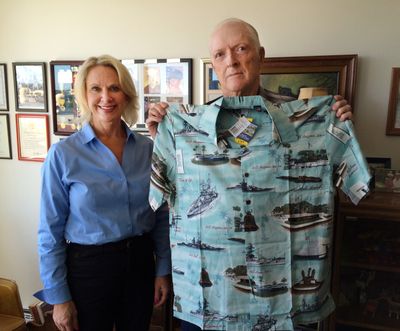This column reflects the opinion of the writer. Learn about the differences between a news story and an opinion column.
Doug Clark: STA seat culprit proves to be battery acid

What do you give the guy who took a bad acid trip?
I couldn’t wait to find out.
Friday was Reparations Day for Spokane’s Bill McChristian.
He’s the 82-year-old Korean War vet who blamed a wet Spokane bus seat for disintegrating his new dungarees one day last May.
McChristian, you may recall, was headed to the VA hospital where he performs volunteer duties twice a week.
An hour or so after departing the bus, McChristian discovered that one of the back pockets of his new blue jeans had given way like the blown hatch on a submarine. The poor man’s fanny was exposed for the public to peruse.
“Half moon,” I believe, is the clinical term for such a condition.
Anyway, lab tests ordered by STA recently arrived. The data shows that a few of you readers were on the money.
Common battery acid was the culprit that caused McChristian’s wardrobe malfunction. It also ate holes in the bus seat’s industrial-grade fabric.
So, with her original doubts gone, STA chief Susan Meyer set up a Friday confab at the former Navy man’s downtown apartment and invited me to tag along.
I was ecstatic to be there. For weeks now, I’ve been more than a little curious as to how Meyer would handle the delicate issue of compensation.
The acid, after all, wasn’t harsh enough to harm McChristian’s rump.
True, it made ruin of his jeans, underwear and the folded hankie he tucked into a back pocket. But those items have a low replacement cost.
The only sore spot was the loss of a commemorative Hawaiian-style naval shirt his daughter gave him. The blue and gray shirt was covered with historic battleships like the Oklahoma and Arizona.
And here’s where Meyer hit it out of the park.
An STA staffer found the shirt available at the gift shop in Pearl Harbor. So Meyer ordered one and paid for it out of her own pocket.
McChristian was at a loss for words when she presented the shirt to him during our meeting.
“I’m sorry you can’t have the one your daughter gave you,” she said, “but this is the next best thing.”
Along with the shirt, Meyer gave McChristian $100 from the STA to cover his damaged duds.
McChristian agreed this was more than generous.
“I’m completely satisfied,” he told me.
“I really appreciate what they’ve done. I’m not a gold digger. I’ve never been out for blood.”
McChristian is an affable guy. I liked him the minute I met him.
The wounds he suffered didn’t come from any acid test. They came from not being believed by transit officials who too quickly went into the ol’ “circle the wagons” mode.
I hate that mode.
But in the meeting’s classiest moment, Mike Toole, head of STA security, offered McChristian his sincere regrets for his initial disbelief.
(Meyer) “pays me to be skeptical,” he said. “And I was a little too skeptical. My apologies.”
And then it was over, time to go our separate ways.
The only detail left hanging is how battery acid got on that seat in the first place.
My mind was made up after watching the footage taken by the on-bus security cameras that day. Suspect No. 1 is clearly the young man who earlier sat in the seat while wearing a backpack.
The pack doesn’t appear to be carrying anything as heavy as a car battery. Nor does the man act suspicious.
He just sat there while – I’m guessing – the acid leaked out of something that was inside his pack and onto the seat.
It would be great if he read this and came forward. He wouldn’t be in trouble or cause any ructions.
It would just be a way of putting a bow onto the package.
But until that happens …
“Who knows?” said Meyer. “That part is a mystery.”
